Ælfgif-who? provides short biographies of early medieval English women. Click on the podcast player if you’d like to hear this newsletter read aloud in my appealing Yorkshire accent.

Eadburh: The Truth about the ‘Wicked Queen’ who Poisoned her Husband
According to King Alfred’s biographer Asser, the kings of Wessex would not allow their wives to be called ‘queen’ because of the stigma one particular tyrannical queen of Wessex had brought upon the role. This wicked queen, a daughter of King Offa and Queen Cynethryth of Mercia, was called Eadburh. Asser tells us the story of her evil and debauched life.
He writes that as soon as Eadburh married King Beorhtric of Wessex, she began to behave as a tyrant like her father Offa. She used trickery to deprive her enemies of power, and when this didn’t work, she poisoned them. Eventually her scheme went wrong, and while she was poisoning a young friend of the king, Beorhtric himself accidentally took her poison. Both men died, and Eadburh fled across the sea, taking the royal treasure with her.
When she arrived at the court of Charlemagne, she offered him gifts. According to Asser, Charlemagne said to her:
‘Choose, Eadburh, whom you wish between me and my son, who is standing with me on this throne.’ She foolishly replied without thinking, said: ‘If the choice is left to me, I choose your son, as he is younger than you.’ Charlemagne smiled and replied to her: ‘Had you chosen me, you would have had my son; but because you have chosen my son, you will have neither him nor me.’
Asser’s Life of King Alfred, translated by Simon Keynes and Michael Lapidge.
Charlemagne gave her a convent in Francia and she became an abbess. This only lasted a few years before she was caught engaging in public debauchery with an English man. Charlemagne ejected Eadburh from the monastery and she apparently fled again to Pavia in Italy, dying a poor and miserable beggar.
Eadburh was certainly a real queen, as she is mentioned in one other source. The Anglo-Saxon Chronicle entry for 789 tells us that ‘In this year King Beorhtric married Offa’s daughter Eadburh’.
If you are a seasoned Ælfgif-who reader you’ll know that when a medieval writer tells us a sensational story about a woman’s sin and debauchery, there’s often a political motive behind it. Like in the case of Æthelgifu and Ælfgifu, the mother and daughter whose historical legacy became a sex scandal involving a ménage à trois at a king’s coronation, the condemnation of Eadburh by Asser has a purpose which could have little to do with the actions of Eadburh herself.
So why tell this story at the beginning of Alfred’s biography? Asser’s immediate purpose was to explain why West-Saxons did not customarily have queens: a custom that Asser himself says is ‘detestable’. He tells us that an exception was made for Judith, Alfred’s stepmother. The low status of West-Saxon royal women is corroborated in the surviving evidence. In the entry for the year of Judith’s wedding and coronation in 856, the Frankish Annals of St Bertin state that consecration of queens was ‘not customary’ for the West-Saxon people. The wives of West-Saxon kings in this period are also conspicuous by their absence in written material and charters; Alfred’s own wife Ealhswith is not even mentioned by name in his biography, despite Asser disapproving of her low status! Asser needed to explain why West-Saxon kings would have a policy that seemed - even in the eyes of a ninth-century monk - regressive.
Another clue as to Asser’s purpose in telling this story is found in the Anglo-Saxon Chronicle. The entry for 839 reads:
In this year King Ecgberht died. Earlier, before Ecgberht became king, King Offa of the Mercians and King Beorhtric of the West Saxons had driven him from England to France for three years. Beorhtric helped Offa because he had married his daughter.
This annal reveals that Ecgberht, Alfred’s own grandfather, had been exiled in his youth by Beorhtric and Offa because of their alliance made over Eadburh. Alfred’s grandfather was thus an enemy of the two men, and Alfred’s family line had displaced the previous one after Beorhtric died. The story about Eadburh uses her to cast aspersions on the two men: it makes Beorhtric look weak and Offa look like a tyrant, while condemning the very marriage alliance which caused both men to unite against Alfred’s grandfather.
It is difficult to surmise to what extent, if any, this story is based in historical truth. The Anglo-Saxon Chronicle does record the death of an Ealdorman Worr alongside that of King Beorhtric, though does not state how they died. Might Queen Eadburh have actually poisoned two men?
While we can’t be sure, it does seem as though there was a preoccupation with the idea of women using poison during Alfred’s reign. Alfred’s Law Codes include an Old English translation of a Latin Biblical law that states ‘thou shalt not permit poisoners/magicians to live’. However Alfred’s own translation makes an adjustment, stating that it is specifically women who consort with magicians, not the magicians themselves, who should be killed. Perhaps the story of Eadburh inspired this law, or vice-versa.
While the historicity of Eadburh’s wicked nature and debauchery is doubtful, it must be stressed that her journey and mobility in Asser’s story are entirely feasible. A neighbouring ruler’s court, a Frankish monastery, and a pilgrimage to Italy are all perfectly reasonable places where a displaced English queen might end up. Alfred's own sister Queen Æthelswith went to Rome in exile. She died while on pilgrimage to Pavia and was buried there. The Liber Vitae (Book of Life) of a convent in Brescia includes a list of names that demonstrates both English men and women visited there in the 850s, including a young Alfred. An early ninth century entry into the Liber Vitae of Reichenau has an entry for an English woman named Eadburg, abbess of a convent in Italy.
A first read of Asser’s story about Queen Eadburh presents us with a wicked and tyrannical murderer who lost the chance to marry Charlemagne or his son through bluntness, who couldn’t keep chaste in her own convent, and who died poor and humiliated. A second consideration might lead us to the conclusion that poor Eadburh’s historical reputation was used as collateral, as history was re-written to favour the victors of a factional dispute. A third examination of the story might lead us to consider it as evidence that the real Eadburh, and widowed queens like her, had options for how they might live the rest of their lives - options that took them to illustrious royal courts, put them in positions of influence, and enabled them to travel thousands of miles.







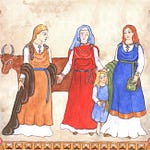
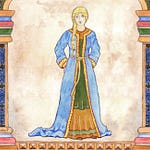
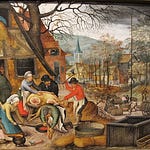
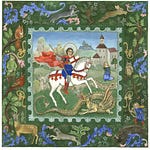



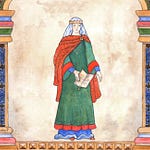
Share this post